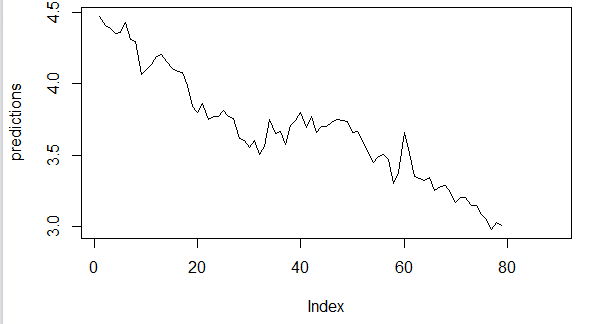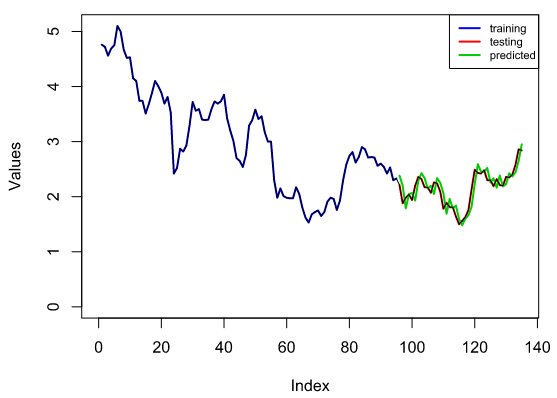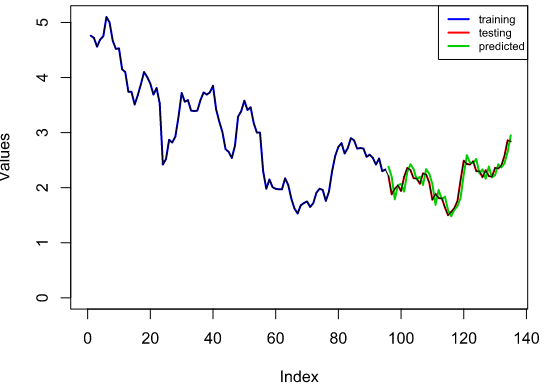Try this block:
The interest rate data can be found on https://fred.stlouisfed.org/graph/?g=NUh
Then you need to press Download button on the webpage (it should be downloaded in csv format)
And then:
library(readr)
Series<-read_csv("~/Downloads/MORTGAGE30US (3).csv"
# transform data to stationarity
diffed = diff(Series, differences = 1)
# create a lagged dataset, i.e to be supervised learning
lags <- function(x, k){
lagged = c(rep(NA, k), x[1:(length(x)-k)])
DF = as.data.frame(cbind(lagged, x))
colnames(DF) <- c( paste0('x-', k), 'x')
DF[is.na(DF)] <- 0
return(DF)
}
supervised = lags(diffed, k)
## split into train and test sets
N = nrow(supervised)
n = round(N *0.66, digits = 0)
train = supervised[1:n, ]
test = supervised[(n+1):N, ]
## scale data
normalize <- function(train, test, feature_range = c(0, 1)) {
x = train
fr_min = feature_range[1]
fr_max = feature_range[2]
std_train = ((x - min(x) ) / (max(x) - min(x) ))
std_test = ((test - min(x) ) / (max(x) - min(x) ))
scaled_train = std_train *(fr_max -fr_min) + fr_min
scaled_test = std_test *(fr_max -fr_min) + fr_min
return( list(scaled_train = as.vector(scaled_train), scaled_test = as.vector(scaled_test) ,scaler= c(min =min(x), max = max(x))) )
}
## inverse-transform
inverter = function(scaled, scaler, feature_range = c(0, 1)){
min = scaler[1]
max = scaler[2]
n = length(scaled)
mins = feature_range[1]
maxs = feature_range[2]
inverted_dfs = numeric(n)
for( i in 1:n){
X = (scaled[i]- mins)/(maxs - mins)
rawValues = X *(max - min) + min
inverted_dfs[i] <- rawValues
}
return(inverted_dfs)
}
Scaled = normalize(train, test, c(-1, 1))
y_train = Scaled$scaled_train[, 2]
x_train = Scaled$scaled_train[, 1]
y_test = Scaled$scaled_test[, 2]
x_test = Scaled$scaled_test[, 1]
## fit the model
dim(x_train) <- c(length(x_train), 1, 1)
dim(x_train)
X_shape2 = dim(x_train)[2]
X_shape3 = dim(x_train)[3]
batch_size = 1
units = 1
model <- keras_model_sequential()
model%>%
layer_lstm(units, batch_input_shape = c(batch_size, X_shape2, X_shape3), stateful= TRUE)%>%
layer_dense(units = 1)
model %>% compile(
loss = 'mean_squared_error',
optimizer = optimizer_adam( lr= 0.02 , decay = 1e-6 ),
metrics = c('accuracy')
)
summary(model)
nb_epoch = Epochs
for(i in 1:nb_epoch ){
model %>% fit(x_train, y_train, epochs=1, batch_size=batch_size, verbose=1, shuffle=FALSE)
model %>% reset_states()
}
L = length(x_test)
dim(x_test) = c(length(x_test), 1, 1)
scaler = Scaled$scaler
predictions = numeric(L)
for(i in 1:L){
X = x_test[i , , ]
dim(X) = c(1,1,1)
# forecast
yhat = model %>% predict(X, batch_size=batch_size)
# invert scaling
yhat = inverter(yhat, scaler, c(-1, 1))
# invert differencing
yhat = yhat + Series[(n+i)]
# save prediction
predictions[i] <- yhat
}


